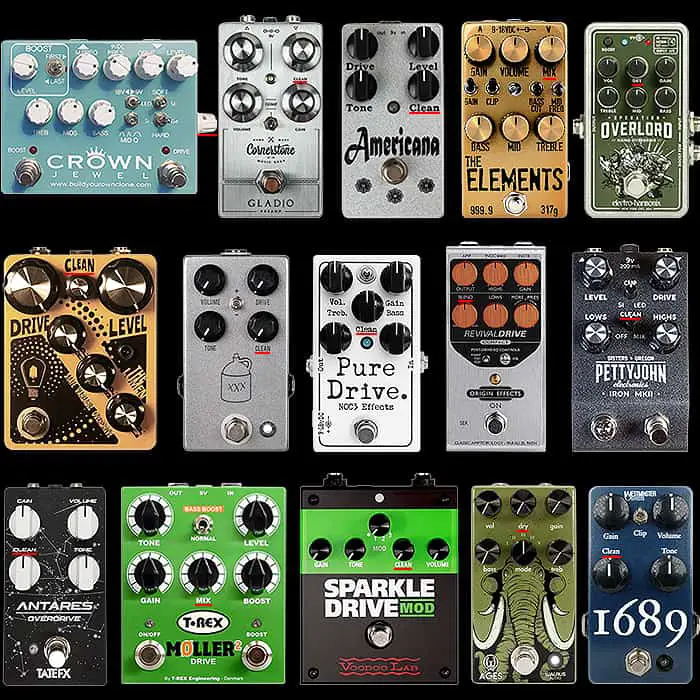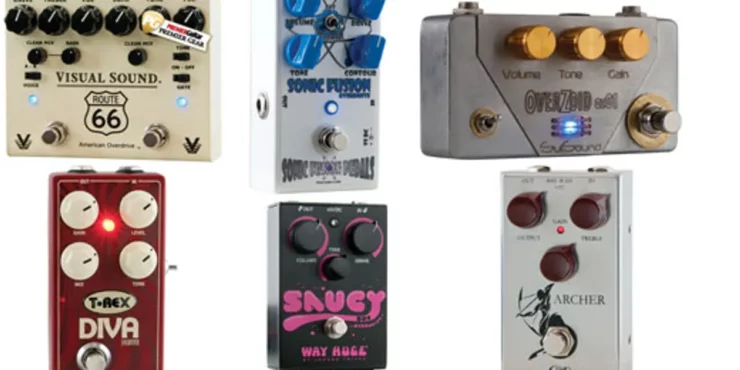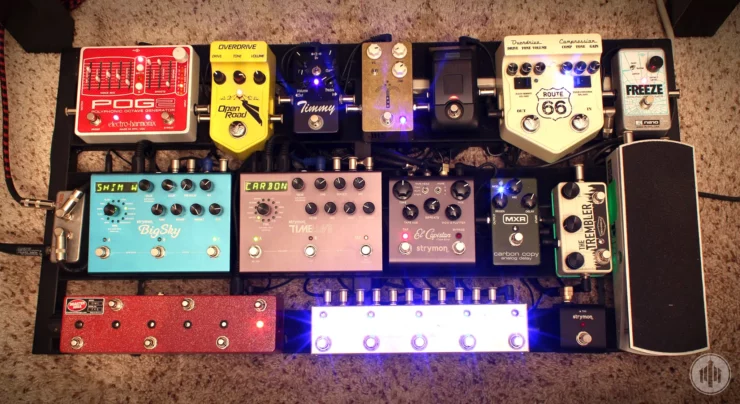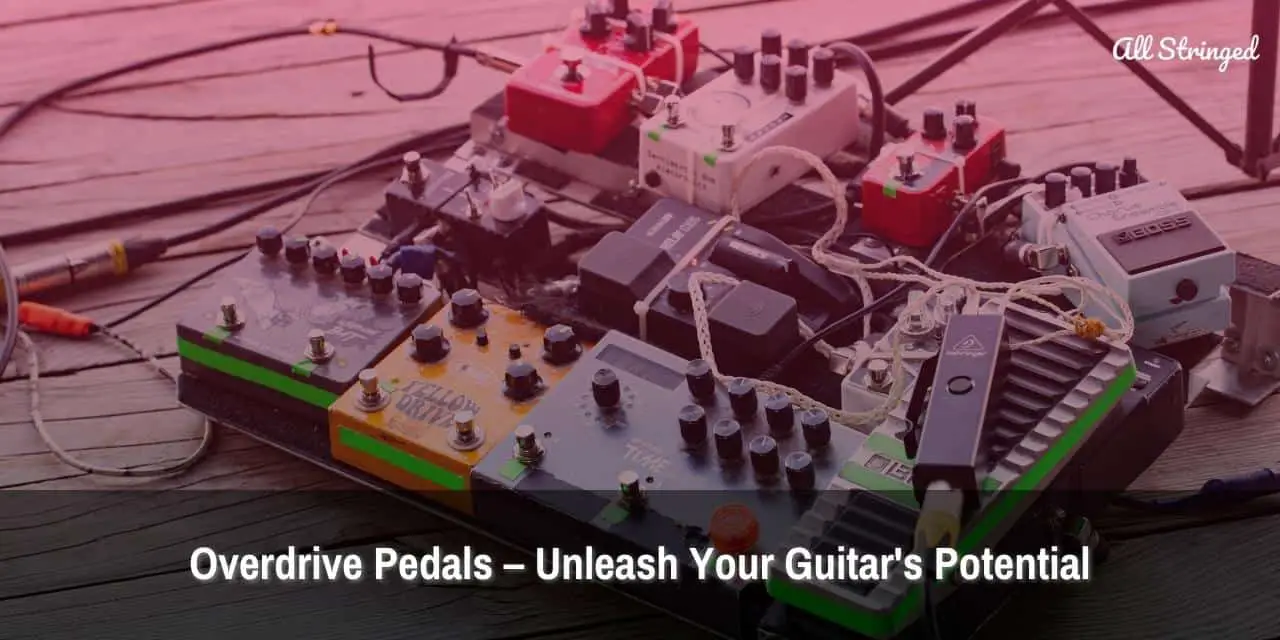Are you tired of your guitar’s sound falling flat? Do you long for that extra punch, that added grit, that will take your playing to the next level? Look no further, because we have the solution you’ve been searching for: the ultimate overdrive pedal.
In this comprehensive guide, we will delve into the world of overdrive pedals, exploring the different types available, the factors to consider when choosing one, and how to use it effectively to unlock your guitar’s true potential. Whether you’re a seasoned pro or just starting out, this article will provide you with the knowledge and tips you need to achieve the best tone possible. So, strap in and get ready to unleash the power of the overdrive pedal!
An overdrive pedal is a popular guitar effect that adds a warm and gritty tone to your sound.
- Types of overdrive pedals include tube screamer, blues driver, and transparent overdrive.
- Factors to consider when choosing an overdrive pedal include your playing style, desired tone, and budget.
- To use an overdrive pedal effectively, start with low gain settings, experiment with different pedal placements, and adjust the tone controls to find your desired sound.
- Common mistakes to avoid when using an overdrive pedal include using too much gain, neglecting to adjust the tone controls, and not experimenting with different pedal placements.
- Tips for getting the best tone with an overdrive pedal include using it to push an already overdriven amp, stacking multiple overdrive pedals for more versatility, and experimenting with different guitar and amp combinations.
Types of Overdrive Pedals
Overdrive pedals are a popular type of guitar effect pedal that musicians use to add a warm, gritty, and dynamic tone to their sound. They are commonly used in various genres of music, including rock, blues, and country. With a wide range of options available in the market, it can be overwhelming to choose the right overdrive pedal for your needs. In this section, we will explore different types of overdrive pedals, each offering unique characteristics and tonal possibilities.
>>> Click here to read our review about the Top 5 Best Overdrive Pedals <<<
Tube Screamer TS808
The Tube Screamer TS808 is one of the most iconic overdrive pedals ever created. It was originally introduced in the late 1970s and has since become a staple in many guitarist’s pedalboards. Known for its smooth and creamy overdrive tone, the TS808 is highly regarded for its ability to push tube amplifiers into natural-sounding distortion. It is often favored by blues and rock guitarists for its mid-range boost and touch-sensitive response.
>>> Click here to read more about Guitar Pedals <<<
Tube Screamer TS9
The Tube Screamer TS9 is a successor to the TS808, offering a similar tone but with a slightly different circuit design. It provides a transparent and dynamic overdrive that preserves the original tone of your guitar and amplifier. The TS9 is known for its versatility, as it can be used to add a subtle boost or dial in a more aggressive overdrive.
BOSS BD-2 Blues Driver
The BOSS BD-2 Blues Driver is a popular overdrive pedal that is often associated with blues guitarists. It delivers a smooth and bluesy overdrive tone with a focus on preserving the dynamics of your playing. The BD-2 is known for its ability to provide a natural breakup that responds well to picking dynamics, making it an excellent choice for expressive playing styles.
Klon Centaur
The Klon Centaur is a highly sought-after overdrive pedal known for its transparent and dynamic tone. It was originally produced in limited quantities in the 1990s and has since gained a legendary status among guitarists. The Klon Centaur offers a wide range of gain, from clean boost to mild overdrive, and is particularly favored for its ability to enhance the natural characteristics of your guitar and amplifier.
Wampler Euphoria
The Wampler Euphoria is an overdrive pedal designed to emulate the sought-after tones of Dumble amplifiers. Dumble amplifiers are known for their smooth and creamy overdrive, and the Euphoria aims to capture that essence in a pedal format. It offers a wide range of tonal possibilities, from clean boost to saturated overdrive, and is favored by many professional guitarists for its versatility and amp-like response.
Fulltone OCD
The Fulltone OCD (Obsessive Compulsive Drive) is a transparent overdrive pedal that aims to provide a natural and amp-like tone. It offers a wide gain range, from clean boost to high-gain overdrive, and is known for its clarity and touch sensitivity. The OCD is highly regarded for its ability to retain the characteristics of your guitar and amplifier while adding a touch of grit and sustain.
In conclusion, the world of overdrive pedals offers a vast array of options, each with its own unique characteristics and tonal possibilities. Whether you’re looking for a smooth and creamy overdrive, a bluesy breakup, a transparent tone, or an amp-like response, there is an overdrive pedal out there to suit your needs. Experimenting with different types of overdrive pedals can help you find your desired tone and take your guitar playing to the next level.

Factors to Consider When Choosing an Overdrive Pedal
When it comes to choosing an overdrive pedal, there are several factors to consider. This crucial decision can greatly impact your guitar tone and overall sound. Whether you’re a beginner or an experienced guitarist, finding the right overdrive pedal can enhance your playing and take your sound to the next level. In this section, we will explore the key factors to consider when choosing an overdrive pedal.
- Gain Range:
The gain range of an overdrive pedal refers to the amount of distortion it can produce. It is important to consider the range that suits your playing style and musical genre. Some pedals offer a wide range of gain, allowing you to achieve everything from subtle, bluesy breakup to heavy, saturated distortion. Others may have a more limited gain range, catering to specific genres or playing styles. - Tone Control:
The tone control on an overdrive pedal allows you to shape the frequency response of your guitar signal. This feature is crucial in sculpting your desired tone. Look for pedals that offer a versatile tone control, allowing you to boost or cut specific frequencies. This will enable you to tailor the overdrive to complement your guitar and amplifier setup. - Transparency:
Transparency refers to how well an overdrive pedal preserves the natural characteristics of your guitar and amplifier. Some pedals are designed to color your tone, adding a distinct flavor to your sound. Others aim to maintain the integrity of your original signal, providing a more transparent overdrive. Consider whether you prefer a pedal that adds its own character or one that allows your guitar and amp to shine through. - Versatility:
Versatility is an important factor to consider, especially if you play a wide range of musical styles. Look for pedals that can handle different genres and playing techniques. Some overdrive pedals offer multiple modes or switchable voicings, allowing you to achieve various tones with a single pedal. This versatility can save you money and pedalboard space in the long run. - Build Quality:
The build quality of an overdrive pedal is crucial, especially if you plan on using it regularly or taking it on the road. Look for pedals made from durable materials that can withstand the rigors of live performances and transportation. Additionally, consider the pedal’s reliability and whether it is true bypass, which ensures that your signal remains unaffected when the pedal is turned off. - Price Range:
Overdrive pedals come in a wide range of prices, from budget-friendly options to high-end boutique pedals. Set a budget that suits your needs and explore pedals within that range. Remember that price doesn’t always dictate quality, and there are excellent overdrive pedals available at various price points. Research and read reviews to find the best value for your money. - User Reviews:
Reading user reviews can provide valuable insights into the performance and reliability of an overdrive pedal. Look for reviews from guitarists who play similar styles of music or have similar gear setups. This can help you gauge whether a particular pedal will meet your specific needs and expectations.
In conclusion, choosing the right overdrive pedal is a personal decision that depends on your playing style, musical genre, and desired tone. By considering factors such as gain range, tone control, transparency, versatility, build quality, price range, and user reviews, you can make an informed decision and find an overdrive pedal that enhances your playing and inspires creativity. Experimenting with different pedals and settings can also help you discover your unique sound and unleash your full potential as a guitarist.
How to Use an Overdrive Pedal Effectively
An overdrive pedal is an essential tool for guitarists looking to add some extra grit and crunch to their tone. Whether you’re playing blues, rock, or even metal, the overdrive pedal can be a game-changer in terms of shaping your sound. In this section, we will explore how to use an overdrive pedal effectively to get the most out of this versatile effect.
Finding the Right Overdrive Pedal
When it comes to overdrive pedals, there are countless options available on the market. Here are a few factors to consider when choosing the right one for your needs:
- Gain Range: Determine the level of distortion you desire. Some overdrive pedals offer a subtle breakup, while others provide more aggressive tones.
- Tone Shaping: Look for pedals with tone controls that allow you to shape the frequency response. This will help you tailor the overdrive to complement your guitar and amplifier.
- Versatility: Consider pedals that offer different modes or settings, allowing you to explore a wider range of tones.
- Price: Set a budget and find a pedal that offers the best value for your money.
Placing the Overdrive Pedal in the Signal Chain
The placement of your overdrive pedal in the signal chain can significantly impact your tone. Here are two common setups:
- Before the Amp: Placing the overdrive pedal before the amplifier input will push the amp harder, resulting in a more saturated and distorted tone.
- In the Effects Loop: If your amplifier has an effects loop, try placing the overdrive pedal in this loop. This setup allows the pedal to drive the preamp section of the amplifier, providing a different tonal character.

Setting the Controls
Understanding the controls on your overdrive pedal is crucial for achieving the desired tone. Here’s a breakdown of the typical controls:
- Gain: Adjusts the amount of distortion or overdrive. Lower settings provide a cleaner tone, while higher settings deliver more saturation.
- Tone: Controls the overall brightness or darkness of the sound. Experiment with this control to find the sweet spot that complements your guitar and amp.
- Level: Determines the output volume of the pedal. Match the level with the bypassed signal to ensure consistent volume when engaging the pedal.
Blending with Your Amp’s Natural Tone
An overdrive pedal works best when it complements the natural tone of your amplifier. Here are a few tips for blending the pedal with your amp:
- Start with a clean amp: Set your amplifier to a clean tone as a foundation, then engage the overdrive pedal to add the desired amount of grit.
- Adjust the gain and tone controls: Experiment with different settings on both the pedal and the amp to find the perfect balance. A slight tweak can make a significant difference in the overall tone.
- Listen and refine: Pay attention to how the pedal interacts with your amp. Make small adjustments to the pedal’s controls to achieve the desired sound.
Using an Overdrive Pedal as a Boost
Aside from providing distortion, an overdrive pedal can also be used as a clean boost to enhance your tone. Here’s how:
- Set the gain low: Keep the gain control on the pedal at a minimum to avoid additional distortion.
- Increase the level: Use the level control to boost the overall volume, adding more presence and sustain to your sound.
- Experiment with placement: Try different positions in the signal chain to find the spot that gives you the desired boost.
Remember, mastering the overdrive pedal takes time and experimentation. Take the time to explore different settings, experiment with different guitars and amplifiers, and listen to how the pedal interacts with your setup. With practice, you’ll discover the perfect overdrive tone that suits your playing style and musical preferences.
Common Mistakes to Avoid When Using an Overdrive Pedal
Using an overdrive pedal is a popular choice among guitarists looking to add some grit and warmth to their tone. However, it’s important to use this effect pedal correctly to achieve the desired results. In this section, we will discuss some common mistakes to avoid when using an overdrive pedal.
- Using Too Much Gain
One of the most common mistakes guitarists make when using an overdrive pedal is cranking up the gain too high. While it may be tempting to dial in a lot of gain for a heavy, distorted sound, excessive gain can lead to a loss of clarity and definition. It’s important to find the right balance between gain and clarity to ensure that your notes ring out clearly and your tone remains articulate. - Neglecting the Tone Controls
Many overdrive pedals come equipped with tone controls that allow you to shape the overall sound. However, some guitarists overlook these controls and leave them at their default settings. Experimenting with the tone controls can help you tailor the overdrive pedal’s sound to complement your guitar and amp setup. Don’t be afraid to adjust the tone controls to find the sweet spot that enhances your tone. - Placing the Overdrive Pedal in the Wrong Position
The position of the overdrive pedal in your signal chain can greatly impact your tone. Placing it before a distortion or fuzz pedal can result in a muddy and indistinct sound. On the other hand, placing it after these pedals can help tighten up your tone and add some extra saturation. Experiment with different pedal placements to find the best position for your overdrive pedal in your signal chain. - Not Adjusting the Volume Level
When engaging an overdrive pedal, it’s important to consider the volume level. If the pedal significantly boosts the volume, it can cause your amp to distort excessively, resulting in an unpleasant sound. To avoid this, make sure to adjust the volume level on your overdrive pedal to match the unity gain level. This ensures that the pedal doesn’t introduce unwanted volume changes when engaged. - Using the Wrong Overdrive Pedal for the Genre
Different overdrive pedals are designed to cater to various genres and playing styles. Using the wrong overdrive pedal for a particular genre can result in a mismatched tone. Research and experiment with different overdrive pedals to find the one that suits your preferred genre. For example, if you play blues, you might opt for a low to medium gain overdrive pedal, while a high gain pedal might be more suitable for metal. - Forgetting to Stack Overdrive Pedals
Stacking multiple overdrive pedals can yield interesting and unique tones. However, it’s important to stack them in the correct order to avoid muddiness or excessive gain. As a general rule, place the pedal with the most gain first in the signal chain and gradually stack pedals with less gain. Experiment with different pedal combinations to find the right stacking order that enhances your tone.
To summarize, using an overdrive pedal correctly can greatly enhance your guitar tone. By avoiding these common mistakes, you can ensure that your overdrive pedal adds the desired warmth and grit without sacrificing clarity and definition. Experimentation is key, so don’t be afraid to try different settings, pedal placements, and combinations to find your perfect overdrive sound.
Tips for Getting the Best Tone with an Overdrive Pedal
An overdrive pedal is an essential tool for guitarists looking to add some grit and crunch to their tone. With the right techniques, you can achieve a wide range of tones and textures that will take your playing to the next level. In this section, we will explore some tips for getting the best tone with an overdrive pedal.
Experiment with Gain Settings
The gain control on your overdrive pedal is responsible for the amount of distortion or saturation in your tone. Experiment with different gain settings to find the sweet spot that suits your playing style. Start with a lower gain setting for a subtle, bluesy overdrive, and gradually increase it for a more aggressive, rock-oriented tone. Remember, every pedal is different, so take the time to familiarize yourself with the specific characteristics of your overdrive pedal.
Adjust the Tone Controls
Most overdrive pedals come equipped with tone controls, such as bass, mid, and treble knobs. These controls allow you to shape the frequency response of your overdriven tone. For a warmer and smoother sound, try rolling off the treble and boosting the bass. If you’re looking for a more cutting and aggressive tone, boost the treble and cut the bass. Experimenting with these controls will help you find the perfect tonal balance that suits your playing style and the music you’re playing.
Consider the Order of Pedals in Your Signal Chain
The order in which you place your overdrive pedal in your signal chain can significantly impact your tone. Placing the overdrive pedal before a distortion or fuzz pedal can result in a more saturated and compressed tone. On the other hand, placing it after these pedals can provide a cleaner and more transparent overdrive sound. Experiment with different pedal orders to find the combination that works best for your desired tone.
Use the Volume Control on Your Guitar
The volume control on your guitar can be a powerful tool for shaping your overdrive tone. Rolling back the volume knob on your guitar can clean up the overdrive, giving you a more dynamic and touch-sensitive response. This technique is particularly useful for achieving cleaner tones when playing rhythm parts or for adding dynamics to your solos. Experiment with different guitar volume settings to discover the range of tones you can achieve with your overdrive pedal.
Combine Overdrive Pedals with Other Effects
Overdrive pedals can be even more versatile when combined with other effects. Here are some ideas to explore:
- Boost Pedals: Use a boost pedal before your overdrive pedal to push it into higher gain territory or to add more volume for solos.
- Delay and Reverb: Add depth and dimension to your overdriven tone by using delay or reverb effects. Experiment with different settings to create lush, atmospheric sounds.
- Modulation Effects: Modulation effects like chorus, phaser, or flanger can add a unique texture to your overdriven tone. Place them after your overdrive pedal to preserve the integrity of your core tone.
With these tips, you can unlock the full potential of your overdrive pedal and achieve the best tone for your playing style. Remember to experiment, trust your ears, and have fun exploring the endless possibilities that an overdrive pedal can offer. Whether you’re looking for a subtle bluesy crunch or a searing rock tone, the right combination of settings and techniques will help you achieve the desired results. Happy playing!

Summary
Unlock the true potential of your guitar with the ultimate overdrive pedal! This comprehensive guide has covered everything you need to know about these magical devices. We explored the different types of overdrive pedals, helping you understand which one suits your style and preferences. Additionally, we discussed the crucial factors to consider when choosing an overdrive pedal, ensuring you make an informed decision.
But it doesn’t stop there! We also delved into the art of using an overdrive pedal effectively. From dialing in the perfect settings to achieving that sweet spot of harmonically rich tones, we’ve got you covered. Moreover, we highlighted some common mistakes to avoid, ensuring you get the most out of your pedal without any hiccups.
To top it off, we shared some expert tips for getting the best tone with an overdrive pedal. Whether you’re a seasoned guitarist or just starting out, these tips will take your sound to the next level. So, get ready to unleash your creativity and captivate your audience with the power of an overdrive pedal.
In conclusion, an overdrive pedal is a game-changer for any guitarist. It adds depth, warmth, and character to your sound, elevating your playing to new heights. With the knowledge gained from this guide, you’re now equipped to make the right choice, use your pedal effectively, and avoid common pitfalls. So, go ahead, grab that overdrive pedal, and embark on a sonic journey like no other!
Frequently Asked Questions for Overdrive Pedal
What is an overdrive pedal and how does it work?
An overdrive pedal is a guitar effects pedal that is used to create a distorted, overdriven sound. It works by boosting the input signal from the guitar and then clipping the waveform to create a warm, saturated tone.
What are the benefits of using an overdrive pedal?
Using an overdrive pedal can add depth, warmth, and sustain to your guitar tone. It can also help you achieve a smooth transition from clean to distorted sounds, making it a versatile tool for guitarists.
Can I use an overdrive pedal with other effects pedals?
Yes, an overdrive pedal can be used in combination with other effects pedals to create unique and customized sounds. It can be used before or after other pedals in your signal chain, depending on the desired effect.



